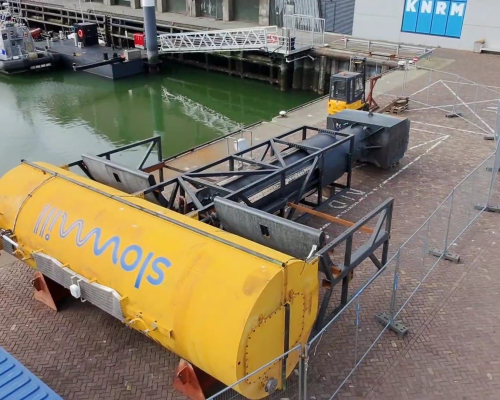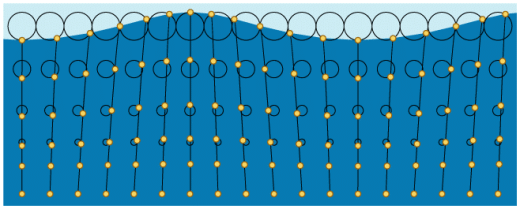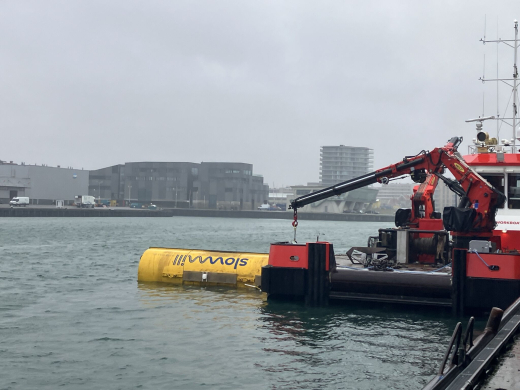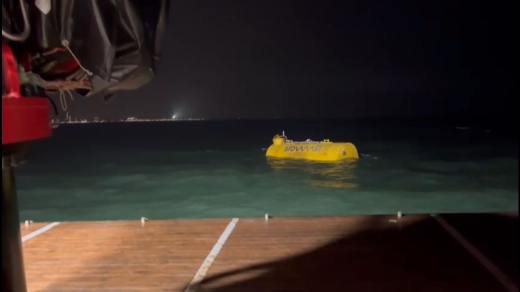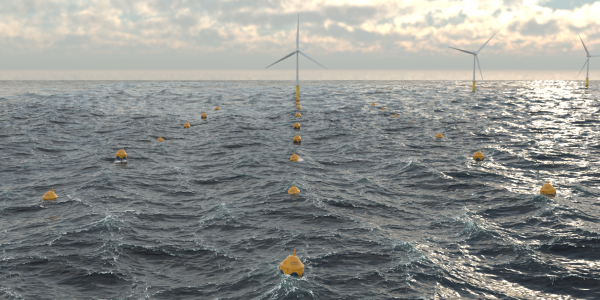Slow Mill successfully tested its floating wave energy turbine in The Hague, harnessing wave power while protecting and enriching the coastline. The tests took place in the testbed of The Hague earlier in March.
Slow Mill's floating structure with blades that operates both vertical and horizontal wave movements have proven to generate as much energy on the North Sea, with relatively small waves, as in oceans. The blades construction are designed to maximize resistance against open flow. The structure is anchored to the seabed and can serve as an artificial reef attracting marine life and enhancing biodiversity and decrease coastal erosion. By placing the systems parallel to the coastline, wave energy is dampened by 10 to 20 percent, reducing the need for costly sand replenishment projects.
Capacity
The latest prototype of the Slow Mill wave energy technology is now fully operational, generating 40 kilowatts of power, enough to supply electricity to 10 households. The next development phase aims to scale up production to 400 kilowatts due to the implementation of multiple turbines, which would provide energy for 100 households.
“This offshore test was crucial for us. We are working for a successful turbine since 2012, after many years of development, first with smaller-scale models in the lab, then on open water and ultimately in the challenging conditions of the North Sea. We have finally proven that our technology works. It was a fascinating moment. For us, the road is open to further scaling up. A wave energy farm combined with an offshore wind farm is our next milestone. We believe, in 2032 we can provide for 10% of the Dutch offshore energy ambition.”
Wind farms
The reason why wind farms are ideal for this is because the space can be used twice, there is a cable to land and the wave energy is still there when there is no wind. It continues at night and the great need for energy supply to islands such as the Wadden Sea, but also worldwide. Wave energy benefits from the higher energy density of water, which is 800 times greater than air. This allows for smaller and lighter installations compared to offshore wind turbines. For reference, a typical windmill has a weight of 12 megawatts, while a Slow Mill system weighs only half a megawatt.
Prototype
The initial prototype is the most expensive due to research and development costs, with current production costs at €2,500 per kilowatt, comparable to early offshore wind energy costs (€1,500 per kilowatt). As the technology scales up, costs are expected to decrease, making wave energy a more economically competitive renewable energy source.
This pioneering project is supported by InnovationQuarter and the WaterFonds, as part of the Energy and Climate Program of the Province of South Holland, ensuring continued development towards a sustainable offshore energy future.
What is Wave Energy?
Wave energy is a form of renewable energy that is generated by the movement of ocean waves. It is harnessed by converting the kinetic and potential energy of waves into electricity using specialized devices. These devices capture the motion of the waves and transform it into mechanical energy, which is then converted into electrical power. Wave Energy complements wind and solar energy as a third main resource because it's a continuous, reliable and abundant energy resource.
About the City by the Sea
The Hague has an 11-kilometer coastline including the well-known beaches such as Scheveningen and Kijkduin, The Hague plays an important role in tourism, sustainable coastal development and maritime innovation. The proximity directly to the North Sea contributes to economic activities such as port-related activity and the development of a sustainable blue economy.
Campus@Sea, next to the Dutch Marine Energy Center and “Proeftuin op de Noordzee”, play an important role within the blue economy of The Hague. This testbed offers the opportunity for different organisations to test their ideas and innovations. The testbed located off the coast of The Hague, is a 10x10 nautical mile innovation hub for maritime research and development. It provides a real-world testing environment for companies, universities and startups working on sustainable energy, autonomous vessels, offshore connectivity and water sports innovations. Examples include floating solar panels, bat and bird radars within windfarms and seaweed cultivation within offshore wind farms, innovations that support energy transition and climate resilience.
Video's of the project

Slow Mill orbital movement
SlowMill technology is being integrated into existing offshore wind farms, with units positioned along the perimeter of the farms. This setup allows for efficient cable connections and energy transmission. Future developments include the integration of floating platforms, further enhancing the technology’s application.

Installation
Installation is done by towing the gravity anchor to its location at sea and sinking it. The Slow Mill can be installed right after or at the same time to mi...
The Blue Economy in The Hague
Dutch Marine Energy - Offshore renewable energy solutions
The international DMEC Accelerator consists of innovation projects, covering the entire trajectory from concept to commercial deployment of offshore renewable energy solutions.
Weco - Wave Energy Collective
Offshore wind farms and wave energy installations can be well combined and a mix of energy sources ensures a more stable energy production.

How a floating radar from The Hague prevents birds and bats from colliding with offshore wind farms
Robin Radar Systems in The Hague helps creating eco-friendlier wind farms and prevent birds and bats from colliding.
